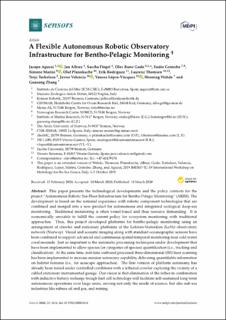| dc.description.abstract | This paper presents the technological developments and the policy contexts for the project “Autonomous Robotic Sea-Floor Infrastructure for Bentho-Pelagic Monitoring” (ARIM). The development is based on the national experience with robotic component technologies that are combined and merged into a new product for autonomous and integrated ecological deep-sea monitoring. Traditional monitoring is often vessel-based and thus resource demanding. It is economically unviable to fulfill the current policy for ecosystem monitoring with traditional approaches. Thus, this project developed platforms for bentho-pelagic monitoring using an arrangement of crawler and stationary platforms at the Lofoten-Vesterålen (LoVe) observatory network (Norway). Visual and acoustic imaging along with standard oceanographic sensors have been combined to support advanced and continuous spatial-temporal monitoring near cold water coral mounds. Just as important is the automatic processing techniques under development that have been implemented to allow species (or categories of species) quantification (i.e., tracking and classification). At the same time, real-time outboard processed three-dimensional (3D) laser scanning has been implemented to increase mission autonomy capability, delivering quantifiable information on habitat features (i.e., for seascape approaches). The first version of platform autonomy has already been tested under controlled conditions with a tethered crawler exploring the vicinity of a cabled stationary instrumented garage. Our vision is that elimination of the tether in combination with inductive battery recharge trough fuel cell technology will facilitate self-sustained long-term autonomous operations over large areas, serving not only the needs of science, but also sub-sea industries like subsea oil and gas, and mining. | |

